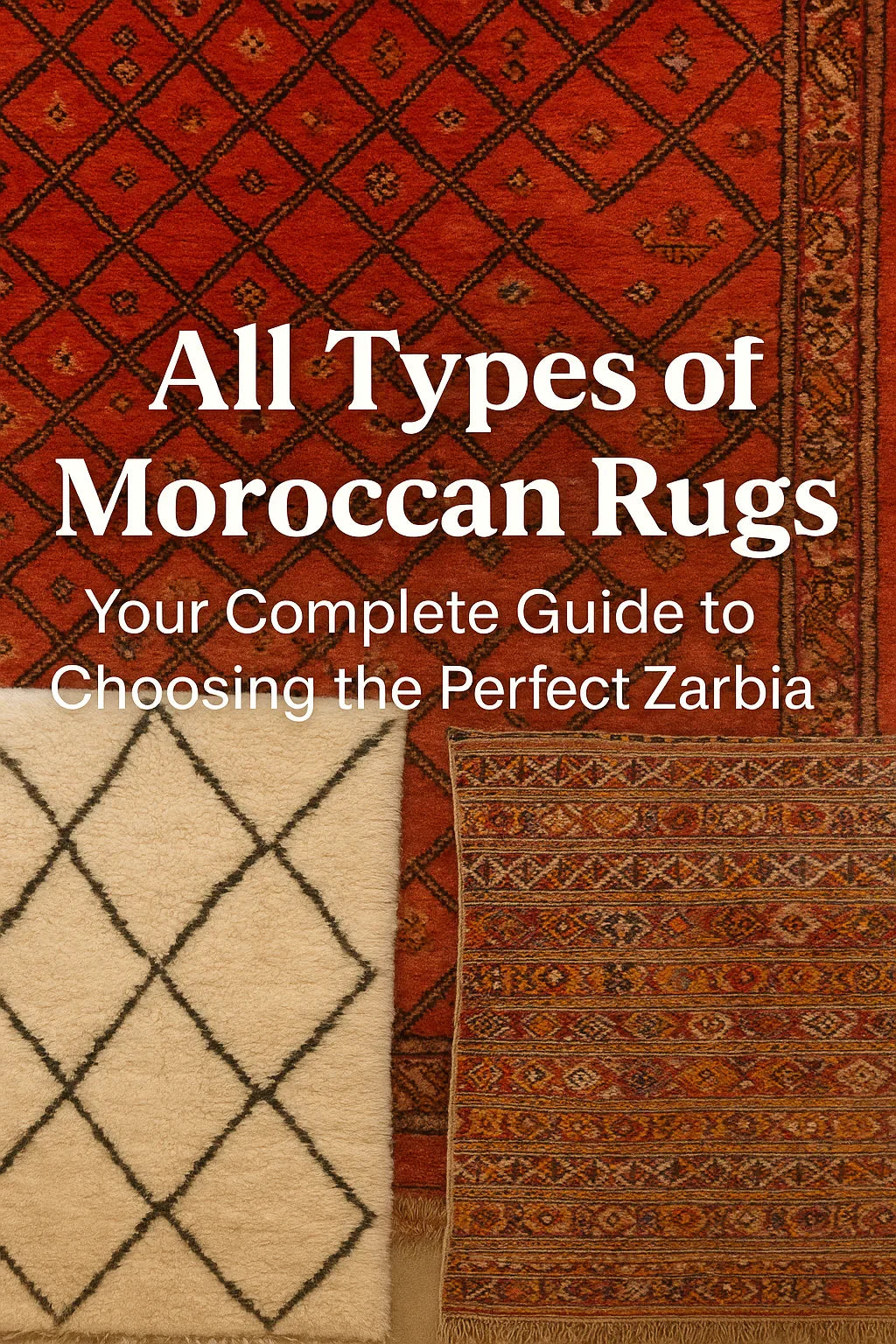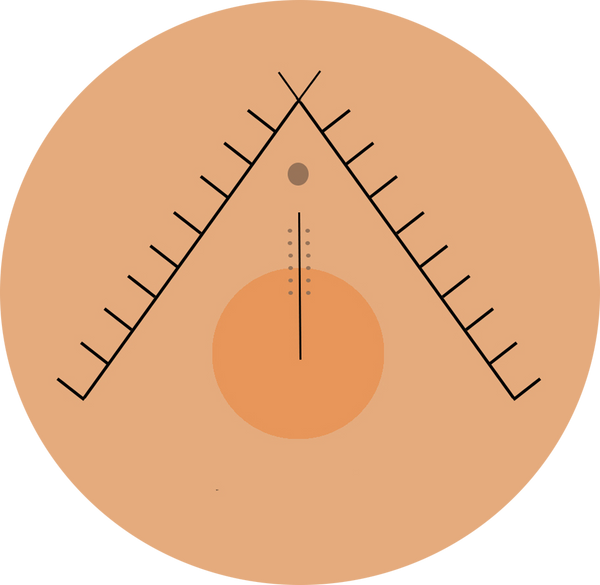
All Types of Moroccan Rugs: Your Complete Guide to Choosing the Perfect Zarbia
Share
Moroccan rugs – known locally as Zarbia – are more than just decorative pieces. They are a symbol of history, culture, and traditional craftsmanship. Whether you’re decorating your living room, hallway, or office, a Moroccan rug adds warmth, color, and authenticity.
In this guide, we’ll explore the main types of Moroccan rugs, how to choose the perfect one, and tips for caring for it.
Azilal Moroccan Rug:

The Azilal rug is one of Morocco’s most unique, expressive, and colorful traditional carpets. It originates from the Azilal region, nestled in the heart of the Middle Atlas Mountains, where Amazigh (Berber) women have passed down the art of weaving from generation to generation.
What makes the Azilal rug stand out is not just its visual beauty, but its soulful storytelling. Each rug is a reflection of the weaver’s thoughts, memories, and cultural identity — transformed into bold colors and abstract symbols.
Azilal Rug: History, Design, Materials, and Home Styling

The Azilal rug is a traditional Moroccan treasure that has been woven for generations by Amazigh women in remote mountain villages.
Each piece is unique — a reflection of the weaver’s emotions, memories, and cultural heritage.
These rugs are known for their vibrant colors — red, pink, green, blue, yellow — and abstract geometric patterns such as diamonds (for protection), zigzags (symbolizing water or life), and dots (representing fertility).
They are handwoven using 100% natural wool, sometimes combined with cotton, and the entire process is manual — from washing the wool to knotting the final design. One rug can take anywhere from 2 to 6 weeks depending on size and detail.
Azilal rugs are perfect for modern and traditional homes alike. You can place them in your living room, bedroom, or even hang them as decorative art. They bring warmth, authenticity, and a touch of Moroccan soul into any space.
Fassi Rug – A Deep Dive into Moroccan Elegance
The Fassi rug is a refined and elegant traditional Moroccan carpet that originates from the historic city of Fez (Fès) — known for its artisanal heritage and intricate craftsmanship. Unlike tribal Berber rugs made in mountain villages, the Fassi rug is a "city rug", reflecting urban sophistication and meticulous attention to detail.
Woven by skilled women artisans using techniques passed down through generations, the Fassi rug combines beauty, structure, and a sense of Moroccan royalty.

Fez has always been a center of craftsmanship in Morocco. The Fassi rug reflects the city's elegance, sophistication, and urban refinement. It is usually woven by skilled women artisans who learn the art from their mothers and grandmothers in the traditional neighborhoods of the medina

Because of its detailed patterns and fine quality, the Fassi rug is often used in formal spaces, such as:
-Living rooms
-Guest rooms
-Entryways
-Riads or traditional homesIt pairs beautifully with classic furniture, Moroccan brass, and carved wood
Fassi rugs are made using high-quality wool or sometimes even silk for luxury versions. The weaving is extremely precise, with tight knots and clean lines. The process is slow and meticulous — it can take several months to finish a large rug
Fassi rugs are known for their high-quality wool, and in more luxurious versions, silk threads may be used to add a soft luster and prestige. These rugs are characterized by:
-Tight, uniform knots
-Clean, symmetrical patterns
-Fine, dense weaving
Weaving a medium or large Fassi rug can take anywhere from several weeks to a few months, depending on the size and complexity of the design. The end result is a rug that feels structured, balanced, and elegant.
Rif Rug – The Hidden Gem of Northern Morocco
The Rif rug (or Rifian rug) is a traditional Moroccan carpet originating from the Rif Mountains in northern Morocco, a region known for its strong Amazigh (Berber) identity, coastal influence, and ancient textile traditions. Unlike the well-known rugs from the Atlas Mountains, the Rif rug is lesser-known globally, but equally rich in symbolism, heritage, and handmade artistry.
These rugs are usually crafted by Rifian women, who use weaving not just as decoration, but as a medium of expression, identity, and cultural continuity.

2. Origin & Cultural Context
The Rif region spans mountainous and coastal areas, blending Berber, Andalusian, and Mediterranean influences. Rifian weaving traditions are passed from mother to daughter, often without written patterns, relying instead on memory and intuition.
Rugs from this region often serve practical purposes (floor covers, bed spreads, wall hangings) but also hold spiritual and protective symbolism rooted in Amazigh belief systems.
3. Materials & Techniques
Rif rugs are traditionally made from:
Wool, often coarse but durable
Sometimes goat hair or recycled textiles
Natural dyes sourced from plants, roots, or minerals
The weaving is done on horizontal or vertical looms, with a technique that mixes flat-weave kilim and knotted pile textures. Many Rif rugs include fringes or tassels, adding a rustic, tribal touch.
Unlike the more refined Fassi or Rabati rugs, Rif rugs often embrace imperfection — with bold, spontaneous designs that reflect the weaver’s spirit and environment.
4. Design & SymbolismDesigns on Rif rugs are bold and abstract. You'll often find:
Zigzags (water/life path)
Triangles (femininity and protection)
X-shapes or diamonds (eye motifs to ward off evil)
Bold stripes (symbolizing family or territory)
Colors range from earthy neutrals (brown, beige, cream) to bright contrasts like red, indigo, orange, and black — depending on local dye availability.
Each rug tells a personal story, without strict symmetry — raw, wild, and emotional.
The Taznakht Rug: Morocco’s Vibrant Woolen Heritage
Hailing from the High Atlas town of Taznakht, these Moroccan rugs are a true expression of Amazigh culture. Handwoven by skilled women artisans using traditional techniques, each rug tells a story through its bold colors and intricate geometric patterns.
Craftsmanship & Colors
Taznakht rugs are crafted from soft, durable wool dyed with natural plant and mineral pigments. Their palette bursts with saffron yellows, deep reds, rich blacks, and earthy browns. The weaving combines flat kilim and knotting methods, creating layers of texture and depth.
Cultural Meaning
More than decorative pieces, these rugs carry powerful symbolism — protection, femininity, connection to nature, and spirituality — deeply rooted in Berber heritage. Every pattern is a narrative, handed down through generations, making each rug unique.
Perfect For
Taznakht rugs add warmth and character to eclectic, bohemian, or traditional interiors, transforming any room into a vibrant, meaningful space.
Discover the artistry of Taznakht — explore our authentic collection today!Shop Now
The Beni Mellal Rug: Rustic Warmth from Morocco’s Middle Atlas
Originating from the central Middle Atlas region near Beni Mellal, this traditional Moroccan rug embodies rural Berber heritage with a gentle, earthy charm. Handmade by women artisans in surrounding villages, the Beni Mellal rug reflects daily life and nature’s rhythms, offering a warm, rustic contrast to more urban styles like Fassi rugs.
Craftsmanship & Design
Woven from natural sheep’s wool that is carefully hand-washed and spun, Beni Mellal rugs blend flat weaving (hanbel) with soft, low-pile knotting techniques. The designs are simple yet striking: bold diamonds, zigzags, and tribal motifs grace the surface, each rug showcasing slight imperfections that celebrate its handmade uniqueness.
The color palette is soothing and natural—creams, muted reds, greens, soft oranges, and subtle purples—invoking the earthy tones of the Middle Atlas landscape.
Cultural Significance & Usage
These rugs carry deep symbolic meaning, representing protection, fertility, and harmony with the natural world. Beyond decoration, they are expressions of the weavers’ beliefs and lifestyle.
Ideal for cozy bedrooms, intimate reading corners, or traditional Moroccan salons, the Beni Mellal rug invites warmth, authenticity, and soul into your living space.
 Seeking a rug with rustic elegance and heartfelt tradition?
Seeking a rug with rustic elegance and heartfelt tradition?Explore Our Beni Mellal Collection
Zerbia L’Henbel – The Art of Flat Weaving in Morocco

The Hanbel rug is one of the oldest and most symbolic forms of Moroccan weaving. Originating from various Berber regions, especially the Middle Atlas and the south, this flatwoven rug stands out for its lightness, practicality, and artistic patterns.
Unlike high-pile rugs like Beni Ourain, the Hanbel is thinner and more flexible — making it easy to fold, move, and use in daily life. It is traditionally woven by women using ancestral techniques passed from mother to daughter.
Craftsmanship & Style
The Hanbel rug is made from wool or a mix of wool and cotton. It uses flat weaving, without pile, often combined with embroidery-like patterns. This gives it a tapestry-like feel, with a focus on design rather than texture.
Designs often feature geometric shapes, Amazigh (Berber) symbols, and contrasting colors like black, white, red, and orange. Each pattern tells a story — of family, nature, spirituality, or protection.
Symbolism & Use
The Hanbel rug is more than a decorative piece. In many villages, it’s used for floor covering, wall décor, or ceremonial purposes like weddings or hosting guests.
Its symbols often represent:
-Nature & agriculture
-Protection against evil
-Feminine strength
-Harmony & balance
Lightweight and full of meaning, it’s perfect for boho interiors, cultural homes, or anyone who values authentic craftsmanship.
Looking for a rug that’s light, symbolic, and full of heritage?
Discover our Hanbel Rugs
We carry many more Moroccan rug styles than the ones mentioned here — each crafted with love and rich cultural meaning.
This blog is just the beginning… stay tuned for more!


